Abstract
Background:
Mucilage is an important polysaccharide with a broad range of physicochemical properties and antioxidant activity that is widely used for various applications in the medicine and food industries.Objectives:
This study aims to evaluate the effect of the extraction method on the physicochemical properties of mucilage extracted from yellow and brown flaxseeds.Methods:
Mucilage was extracted by different methods: heating, sonotrode, and bath sonication. The extracted mucilage was evaluated for mucilage extraction efficiency (MEE%), solubility, water-binding capacity (WBC%), antioxidant activity, and foam stability.Results:
In all extraction methods, the MEE% of yellow flaxseed was significantly higher than that of brown flaxseed. The antioxidant activity of mucilage extracted from brown and yellow flaxseed was 43.65 ± 1.86% and 12.65 ± 1.23%, respectively (P < 0.001). In all extraction methods, the solubility of mucilage was increased by enhancing the temperature. Significantly, higher solubility (P < 0.01) and stronger foam stability (P < 0.001) was obtained for mucilage extracted from brown flaxseed. The highest foam stability was obtained by the sonotrode method. Mucilage extracted by sonotrode and bath sonication methods showed significantly stronger (P < 0.01) water-binding capacity (WBC%) compared to that of the heating method.Conclusions:
Our results showed that the ultrasonic methods, especially sonotrode, due to their positive effects on physicochemical properties of mucilage, could be more appropriate methods for extraction of mucilage.Keywords
Flaxseed Mucilage Antioxidant Activity Extraction Method Foam Stability Water-Binding Capacity
1. Background
Flaxseed (Linum usitatissimum L.) is an important functional food due to its high dietary fiber, alpha-linolenic acid, protein, and large amounts of phytochemicals (1). Its total amount of dietary fiber is about 40 %. Although most of the dietary fiber in flaxseed is insoluble (27 - 36%), it is a rich source of soluble dietary fiber (mucilage), about 7 - 14%. Dietary fibers play an important role in preventing diseases such as diabetes, cardiovascular diseases, and intestinal cancers (2).
Polysaccharides (mucilages) extracted from the outer layers of the grains are important in food industries due to their good emulsifying properties, used for suspension of particulates, stabilization of emulsions, control of crystalization, formation of films, and thickening (3).
Researches have shown that several factors, including solvent to solids ratio, pH of extraction conditions, and process temperature, significantly impact the quality of the extracted mucilage and its efficiency (4). Heat extraction (the common method) is the main method for mucilage extraction. It is a simple and safe method but requires a high temperature and a long time, which leads to the decomposition of polysaccharides and changing their properties (5). Nowadays, ultrasonic extraction methods draw considerable attention to the extraction of bioactive and polysaccharide compounds due to their simplicity, higher efficacy, and cost-effective properties (6). One of the most important mechanical effects of ultrasound waves is the formation of microchannels, which is caused by the cavitation phenomenon near the surface of solids. This mechanical effect of ultrasound waves can facilitate the release of plant compounds by destroying the cell wall and increasing the mass transfer of cell contents (7). The effect of ultrasound treatment on rheological properties and particle size dispersion of three types of Iranian tragacanth mucilage was evaluated by Farzi et al. Their results showed that increasing ultrasound application time decreased the viscosity and particle size of the dispersion (7). Fabre et al. extracted flaxseed mucilage by ultrasound, microwave, and conventional methods. They found that the ultrasonic waves were more efficient than microwaves and conventional methods in mucilage extraction (5).
2. Objectives
Because of the many health benefits of mucilage, in this study, attempts have been made to investigate the effect of extraction methods on physicochemical properties of mucilage extracted from brown and yellow flaxseeds. To do this, the main parameters of mucilage, such as extraction efficiency, solubility, foam stability, antioxidant activity, and water-binding capacity, were evaluated and compared.
3. Methods
3.1. Materials
Yellow and brown flaxseeds were obtained from Sepahan Pakan Bazar Company, and all chemical materials were purchased from Merck Company.
3.2. Sample Preparation
The whole grains of flaxseeds cultivated in the Ardestan region of Isfahan province were cleaned, separated from impurities, washed with distilled water (DW), and dried at room temperature.
3.3. Extraction of Mucilage
3.3.1. Extraction by Heating Method
The extraction was performed by boiling 1 gram of yellow or brown flaxseed grains in 20 mL of DW for 120 min at 80°C on a magnetic stirrer at a speed of 300rpm, and then the seeds were separated from the colloidal solution by a Buchner funnel. Solvent excess was eliminated by centrifugation (5000 rpm, 15 min) (8). The purified sample was dried under a freeze-dryer. Then it was kept in a polyethylene cover to determine the extraction efficiency and other experiments.
3.3.2. Extraction by Sonotrode
In this method, 1 gram of flaxseed grains was dissolved in 20 mL of DW and exposed to direct ultrasound waves of sonotrode for 20 min using Hielscher ultrasonic device (UIP1000 hd transducer, Germany) with a frequency of 24 kHz and a power of 700 watts. To prevent a sudden rise in temperature, the sample was placed in an icy insulated container, and the temperature was kept around 35 ± 2°C. After sonication, heating was performed at 80°C for 10min, and then the grains were separated from the solution by filtration. Finally, the mucilage was precipitated by 96% ethanol and dried under a freeze-dryer.
3.3.3. Extraction by Bath Sonication
In this method, 1 gram of flaxseed grains was dissolved in 20 mL of DW and exposed to bath sonication (Sonorex Digiplus, BANDELIN, Germany) with 100% nominal power at 35 ± 2°C for 20 min. Then, to complete the mucilage extraction, the process was continued for 10min at 80°C. The extracted mucilage was precipitated and dried, as mentioned before.
3.4. Mucilage Extraction Efficacy
Equation 1 was used to determine the mucilage extraction efficacy (MEE%):
Where w1 is the weight of the flaxseed sample and w2 is the weight of extracted mucilage (9).
3.5. Antioxidant Activity
Antioxidant activity of mucilage was determined by trapping the free radical compound DPPH. DPPH (2, 2-diphenyl-1- picrylhydrazyl) is a free radical with a single electron on an N atom which has a strong absorption peak at 517 nm and produces a dark purple color. To do this, 3.9% of the total DPPH was added to 0.1 mL of the mucilage (20 mg in 0.5 mL of DW), then the whole was extremely vortexed. The tubes were placed in a dark place for 1 h. In the control sample, the extracted sample was replaced by 0.1 mL DW. In standard samples, the extracts were replaced by 0.1 mL of gallic acid (125, 250, 500, 1000 ppm). Equation 2 was used to determine the DPPH inhibition percent by the extract:
Where Ac and As are control and sample absorbance, respectively (10).
3.6. Mucilage Solubility
A solution of 0.5% mucilage was treated in hot water at 100°C for 30 min. After cooling to 10°C, it was centrifuged at 5000 rpm for 10min. The supernatant was recovered, and the final mucilage concentrations were determined as total solids dried at 105°C for 120 min (11). Then the solubility of mucilage was obtained by Equation 3:
Where Cs is the concentration of mucilage in supernatant and Ci is the initial concentration of mucilage.
3.7. Water-banding Capacity
To do this, a 0.5% mucilage solution was centrifuged at 3000 rpm for 10 min. After removing of supernatant, the jelly substance was weighed (12). Water-banding capacity (WBC) was measured by the Equation 4:
Where w1 is the weight of the initial flaxseed sample, and w2 is the weight of swollen mucilage.
3.8. Foam Stability
For this purpose, 1 gram of the mucilage in 100 mL of DW was mixed for 5min and immediately transferred to a 250 mL graduated cylinder. Then, the decrease in foam’s volume was measured at different intervals for a total of 60 min (13). The foam stability percentage (FS%) was calculated according to Equation 5.
3.9. Statistical Analysis
Statistical analysis was performed by GraphPad Prism V8, and the difference between groups was considered statistically significant when P-values was < 0.05.
4. Results
4.1. Mucilage Extraction Efficiency
The MEE% results have been presented in Figure 1. In all three extraction methods, the yield of mucilage extracted from yellow flaxseed was significantly (P < 0.001) higher than that from brown flaxseed.
The yield of mucilage extracted from brown and yellow flax using different methods (*** P < 0.001).
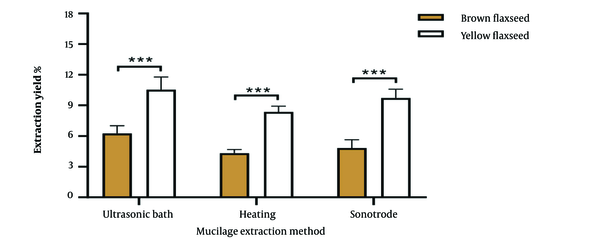
As can be seen, the highest extraction efficiency was related to yellow flaxseed and obtained by bath sonication. In both types of flaxseeds, extraction of mucilage by the bath sonication method was more efficient than the heating method (P < 0.01). Although in both types of flaxseeds, the extraction efficiency by the bath sonication method was higher than the sonotrode method, their difference was insignificant.
4.2. Antioxidant Activity
Antioxidant activity of mucilage was determined by the DPPH test. The antioxidant compounds of mucilage can react with free radicals DPPH and change the purple color of this substance to yellow by reducing the stability of free radicals. DPPH radical scavenging power is measured based on the amount of color change created. The results showed that the highest antioxidant activity was obtained in brown flaxseed using the sonotrode method (Figure 2A). As shown, there is a significant difference (P < 0.001) in the antioxidant activity of mucilage extracted from yellow and brown flaxseed in thermal and sonotrode methods. However, this difference was not significant in the bath sonication method. The higher antioxidant capacity of brown flaxseed compared to yellow flaxseed has been previously reported by Sargi et al. (14).
Antioxidant activity of mucilage extracted from brown and yellow flaxseed (*** P < 0.001, NS: Not significant).
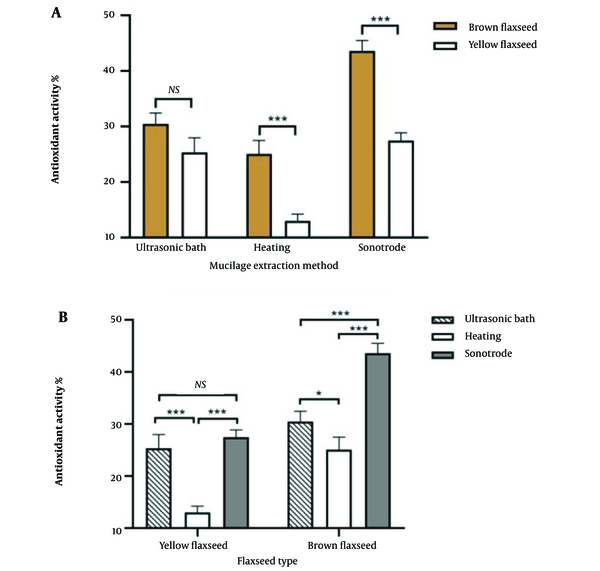
As seen in Figure 2B, in both flaxseeds, significant (P < 0.001) higher antioxidant activity was obtained for sonotrode and bath sonication methods, while minimum antioxidant activity was detected for the heating method.
4.3. Mucilage Solubility
This result showed that by increasing temperature, the solubility of mucilage also increases. The solubility of brown flaxseed mucilage at different temperatures and in all extraction methods was significantly (P < 0.01) higher than that of yellow flaxseed. Mucilage extracted from yellow flaxseed showed the lowest solubility (11 ± 0.87 %) at 20°C by heating method and the highest solubility (36.2 ± 1.88%) at 100°C by sonotrode. Also, mucilage extracted from brown flaxseed showed the lowest solubility (19.50 ± 0.75%) at 20°C by heating method and the highest solubility (39.76 ± 1.42%) at 100°C by sonotrode method (Figure 3).
Solubility of mucilage extracted from brown (A) and yellow flaxseed (B) by three different methods in comparison with control (alginate). The results are repeated three times and expressed as mean ± SD.
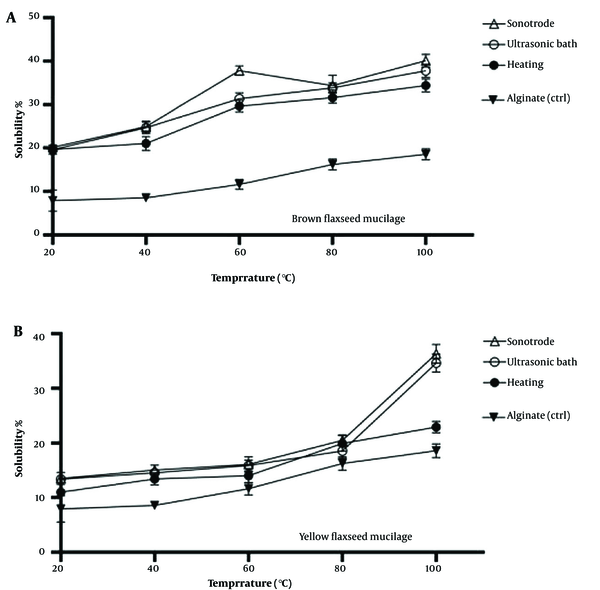
The solubility of alginate at different temperatures ranged from 6.94 ± 0.86% at 20°C to 18.60 ± 1.15% at 100°C. In all three methods and in both types of flaxseed, the solubility of mucilage was significantly (P < 0.001) higher than that of the control (alginate). The results showed that in both types of flaxseeds, the solubility of mucilage extracted by sonotrode method was more than the bath sonication method, and the bath sonication method was more than the thermal method.
4.4. Water-binding Capacity
Water-binding capacity of dietary fiber is one of the crucial factors in food industries that impact not only the physiological properties of food but also the ingredient functionality, product yield, and shelf life. Water-binding capacity represents the ability of a compound to bind with water molecules to produce gels or viscous solutions. In general, in both flaxseeds, the extracted mucilage by sonotrode and bath sonication methods had significantly (P < 0.05) higher WBC than that of the heat-extracted method. Also, in both types of flaxseed, the amount of WBC in the bath sonication was higher than that in the sonotrode method, which means that by increasing the intensity of ultrasonic waves (in the sonotrode method), the amount of WBC decreases.
In addition, in all three extraction methods, the rate of water absorption in brown flaxseed mucilage was significantly (P < 0.01) higher than that of yellow flaxseed (Figure 4).
Results of the water-binding capacity of mucilage extracted by three different methods. (n = 3, mean ± SD, **P < 0.01).
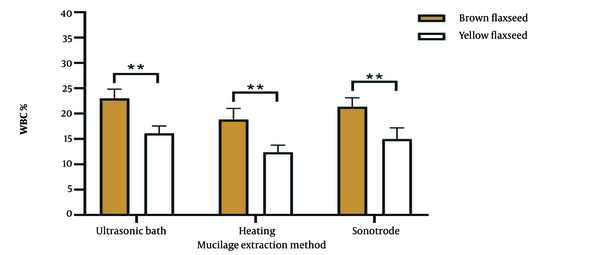
4.5. Foam Stability
Foam stability plays an essential role in creating the desired rheological properties in food. Thermodynamic instability is a significant feature of the foam that causes the foam to collapse over time, so using foam stabilizers seems necessary. According to the results, the effect of the extraction method on foam stability was significant with 95% probability. The foam stability of different samples is shown in Figure 5.
Foam stability of mucilage extracted from brown (A) and yellow (B) flaxseed. (n = 3, mean ± SD).
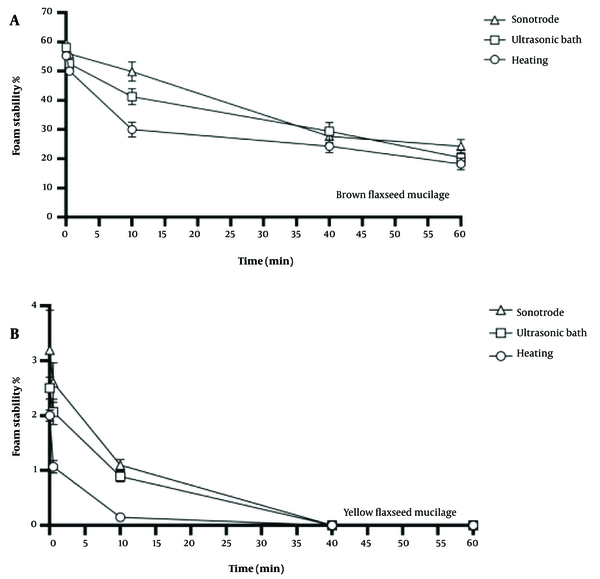
In all three extraction methods, the stability of mucilage foam extracted from brown flaxseed was significantly (P < 0.001) higher than that of yellow flaxseed, and the highest foam stability was obtained by sonotrode method.
5. Discussion
The high amount of mucilage extracted from yellow flaxseed compared to brown flaxseed can be related to the high amount of oil in brown flax that reduces the heat and water penetration into the grain tissue and decreases the extraction of mucilage. Increasing the extraction efficiency in ultrasonic method compared to conventional heating can be related to the cavitation phenomenon induced by ultrasonic waves. The propagation of ultrasonic waves and the explosion of bubbles cause turbulent flow and turbulence in the system, which facilitates the accidental collision of particles at high speeds and ultimately leads to increased mass transfer. In addition, cavitation near the liquid-solid surface creates microchannels that are involved in the attrition and scrubbing of the particle surface. This leads to exposure to newer levels and thus increases the mass transfer (15). Higher extraction efficiency of the ultrasonic methods can also be attributed to the increase of osmotic pressure around the flaxseeds due to the creation of microchannels.
Moreover, in the ultrasonic method, microbubbles are created, attached, and reach a critical size point where they disintegrate into releasing a large amount of energy. In this process, a high amount of temperature and pressure was generated, rupturing the cell wall of the plant matrix and releasing its contents into the environment (16, 17). Our results agreed with the results of Farahnaky et al. (6). They also found that ultrasonic is an appropriate method for isolating mucilaginous hydrocolloids from Salvia macrosiphon seeds. Similar results have been reported by Pereira and his co-workers (18). They showed that the extraction of mucilage from mutamba seeds through the ultrasonic method leads to full recovery of the mucilage in a short time without any changes in its quality and the primary structure.
Antioxidant activity of mucilage can be attributed to the presence of lignin, phenolic, and flavonoid compounds that enter the mucilage during the extraction process (19). Lignans are the most critical compounds in flaxseed that have antioxidant activity. The most important lignans in flaxseed are Secoisolariciresinol (SECO), Secoisolariciresinol diglucoside (SDG), Pinoresinol, Matairesinol (MAT), and Isolariciresinol (20). The higher antioxidant activity of brown flaxseed compared to yellow flaxseed is related to its higher content of phenolic compounds such as lignans (14).
More antioxidant activity obtained in the sonotrode method may be attributed to the destruction of grain cell wall due to cavitation phenomenon, which increases the content of phenolic compounds in the media, which in turn enhance the antioxidant activity through more scavenging of free radicals (21).
An increase in mucilage solubility by increasing the temperature can be due to the breaking hydrogen bonds between polysaccharide chains and exposure of hydroxyl groups to the water’s molecules (8). Differences in the mucilage solubility in different extraction methods may be related to the difference in the molecular weight of mucilage. The two main factors that impact the solubility of polysaccharides are their structure and molecular weight, so by decreasing the molecular weight, the solubility of polysaccharides is increased (22, 23). The low molecular weight of mucilage was produced in ultrasonic methods because of the cavitation phenomenon that leads to molecular irregularity and structural destruction in polysaccharides. As reported by other researchers (14, 24), a heating process was required to dissolve some of the hydrocolloids to induce the whole viscosity.
The higher WBC% of mucilage extracted from ultrasonic methods can also be related to the cavitation phenomenon. The intact and uniform structure of macromolecules positively impacts their WBC% properties. Higher WBC% in the bath sonication method may be explained by the fact that the lower degradation and disruption of uniformity in polysaccharide structures occur in this method (25). Lower disruption of polysaccharides during the extraction process may be explained by the higher water-binding capacity of brown flaxseed concerning the yellow type.
The higher foam stability in the sonotrood method may be related to polysaccharides, with a lower molecular weight, produced by this method. These polysaccharides have a higher adsorption rate at the surface of the foam bubbles, leading to more foam stability (24). The bonding between water molecules and free hydroxyl groups of polysaccharides, which are more exposed by the ultrasound methods (especially in the sonotrode method), is an effective factor in foam stability (24).
5.1. Conclusions
The results of the present study showed that using ultrasonic waves increases the extraction efficiency, solubility, and stability of the foam in the extracted mucilage. According to this, ultrasonic methods as a short process with low energy are suggested to extract mucilage with suitable functional properties.
References
-
1.
Amiri MS, Mohammadzadeh V, Yazdi MET, Barani M, Rahdar A, Kyzas GZ. Plant-Based Gums and Mucilages Applications in Pharmacology and Nanomedicine: A Review. Molecules. 2021;26(6). [PubMed ID: 33809917]. [PubMed Central ID: PMC8004199]. https://doi.org/10.3390/molecules26061770.
-
2.
Azizi R, Farahnaky A. Ultrasound assisted-viscosifying of kappa carrageenan without heating. Food Hydrocolloids. 2016;61:85-91. https://doi.org/10.1016/j.foodhyd.2016.05.006.
-
3.
Cai Z, Qu Z, Lan Y, Zhao S, Ma X, Wan Q, et al. Conventional, ultrasound-assisted, and accelerated-solvent extractions of anthocyanins from purple sweet potatoes. Food Chem. 2016;197(Pt A):266-72. [PubMed ID: 26616949]. https://doi.org/10.1016/j.foodchem.2015.10.110.
-
4.
Doublier J, Garnier C, Cuvelier G. Chapter Gums and Hydrocolloids. Functional Aspects. CRC Press; 2016. p. 285-332.
-
5.
Fabre J, Lacroux E, Valentin R, Mouloungui Z. Ultrasonication as a highly efficient method of flaxseed mucilage extraction. Ind Crops Prod. 2015;65:354-60. https://doi.org/10.1016/j.indcrop.2014.11.015.
-
6.
Farahnaky A, Bakhshizadeh-Shirazi S, Mesbahi G, Majzoobi M, Rezvani E, Schleining G. Ultrasound-assisted isolation of mucilaginous hydrocolloids from Salvia macrosiphon seeds and studying their functional properties. Innov Food Sci Emerg Technol. 2013;20:182-90. https://doi.org/10.1016/j.ifset.2013.06.003.
-
7.
Farzi M, Saffari MM, Emam-Djomeh Z, Mohammadifar MA. Effect of ultrasonic treatment on the rheological properties and particle size of gum tragacanth dispersions from different species. Int J Food Sci Technol. 2011;46(4):849-54. https://doi.org/10.1111/j.1365-2621.2011.02558.x.
-
8.
Kasote DM. Flaxseed phenolics as natural antioxidants. Int Food Res J. 2013;20(1):27-34.
-
9.
Kunyanga CN, Imungi JK, Okoth M, Momanyi C, Biesalski HK, Vadivel V. Antioxidant and antidiabetic properties of condensed tannins in acetonic extract of selected raw and processed indigenous food ingredients from Kenya. J Food Sci. 2011;76(4):C560-7. [PubMed ID: 22417336]. https://doi.org/10.1111/j.1750-3841.2011.02116.x.
-
10.
Heydari Majd M, Rajaei A, Salar Bashi D, Mortazavi SA, Bolourian S. Optimization of ultrasonic-assisted extraction of phenolic compounds from bovine pennyroyal (Phlomidoschema parviflorum) leaves using response surface methodology. Ind Crops Prod. 2014;57:195-202. https://doi.org/10.1016/j.indcrop.2014.03.031.
-
11.
Mazza G, Biliaderis CG. Functional Properties of Flax Seed Mucilage. J Food Sci. 1989;54(5):1302-5. https://doi.org/10.1111/j.1365-2621.1989.tb05978.x.
-
12.
Dakia PA, Blecker C, Robert C, Wathelet B, Paquot M. Composition and physicochemical properties of locust bean gum extracted from whole seeds by acid or water dehulling pre-treatment. Food Hydrocoll. 2008;22(5):807-18. https://doi.org/10.1016/j.foodhyd.2007.03.007.
-
13.
Norde W. Colloids and interfaces in life sciences and bionanotechnology. CRC Press; 2011.
-
14.
Sargi SC, Silva BC, Santos HMC, Montanher PF, Boeing JS, Santos Júnior OO, et al. Antioxidant capacity and chemical composition in seeds rich in omega-3: chia, flax, and perilla. Food Sci Technol. 2013;33(3):541-8. https://doi.org/10.1590/s0101-20612013005000057.
-
15.
Sharmila G, Nikitha VS, Ilaiyarasi S, Dhivya K, Rajasekar V, Kumar N, et al. Ultrasound assisted extraction of total phenolics from Cassia auriculata leaves and evaluation of its antioxidant activities. Ind Crops Prod. 2016;84:13-21. https://doi.org/10.1016/j.indcrop.2016.01.010.
-
16.
Shotipruk A, Kaufman PB, Wang HY. Feasibility study of repeated harvesting of menthol from biologically viable Mentha x piperata using ultrasonic extraction. Biotechnol Prog. 2001;17(5):924-8. [PubMed ID: 11587585]. https://doi.org/10.1021/bp010074u.
-
17.
Singh KK, Mridula D, Rehal J, Barnwal P. Flaxseed: a potential source of food, feed and fiber. Crit Rev Food Sci Nutr. 2011;51(3):210-22. [PubMed ID: 21390942]. https://doi.org/10.1080/10408390903537241.
-
18.
Pereira GA, Silva EK, Peixoto Araujo NM, Arruda HS, Meireles MAA, Pastore GM. Obtaining a novel mucilage from mutamba seeds exploring different high-intensity ultrasound process conditions. Ultrason Sonochem. 2019;55:332-40. [PubMed ID: 30857825]. https://doi.org/10.1016/j.ultsonch.2019.01.010.
-
19.
Ursoniu S, Sahebkar A, Andrica F, Serban C, Banach M; Lipid, et al. Effects of flaxseed supplements on blood pressure: A systematic review and meta-analysis of controlled clinical trial. Clin Nutr. 2016;35(3):615-25. [PubMed ID: 26071633]. https://doi.org/10.1016/j.clnu.2015.05.012.
-
20.
Vilkhu K, Mawson R, Simons L, Bates D. Applications and opportunities for ultrasound assisted extraction in the food industry — A review. Innov Food Sci Emerg Technol. 2008;9(2):161-9. https://doi.org/10.1016/j.ifset.2007.04.014.
-
21.
Wanasundara PKJPD, Shahidi F. Removal of flaxseed mucilage by chemical and enzymatic treatments. Food Chemistry. 1997;59(1):47-55. https://doi.org/10.1016/s0308-8146(96)00093-3.
-
22.
Cui SW. Food carbohydrates: chemistry, physical properties, and applications. CRC Press; 2005. p. 162-214.
-
23.
Wang X, Wu Y, Chen G, Yue W, Liang Q, Wu Q. Optimisation of ultrasound assisted extraction of phenolic compounds from Sparganii rhizoma with response surface methodology. Ultrason Sonochem. 2013;20(3):846-54. [PubMed ID: 23246040]. https://doi.org/10.1016/j.ultsonch.2012.11.007.
-
24.
Ziolkovska A. Laws of flaxseed mucilage extraction. Food Hydrocolloids. 2012;26(1):197-204. https://doi.org/10.1016/j.foodhyd.2011.04.022.
-
25.
Wannerberger K, Nylander T, Nyman M. Rheological and Chemical Properties of Mucilage in Different Varieties from Linseed (Linum usitatissimum). Acta Agriculturae Scandinavica. 1991;41(3):311-9. https://doi.org/10.1080/00015129109439914.
